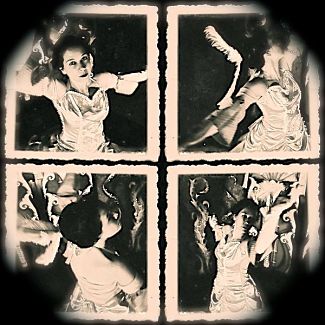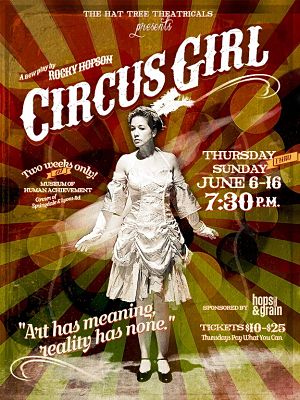Review: Circus Girl by Hat Tree Theatricals
by David Glen Robinson
Circus Girl, written by Rocky Hopson, is a coming-of-age play like few others. Set in the 1890s in the Midwest and Rocky Mountains, the play proceeds initially like the adventures of one of many “Little Nells” of the dime novels of that time. If those stories had finished with any of the realism and hard times of that age depicted in this play, very few “Little Nells” would have survived to tell the tale. 'Circus Girl' is the name given to a very young orphan by her circus family; the circus travels, but then settles in Kansas City when the owner buys a theatre for a home base. All dreams are shattered when the Panic of 1893 causes a riotous run on America’s banks. The bank forecloses on the circus’s theatre loan; the performers and owner lose everything, and Circus Girl is cast loose in depressed America with absolutely nothing.
The first point of appreciation of the play is the beauty that's presented on stage against the background of decay. The costumes are at times truly sumptuous and approach period accuracy, at least as far as I could evaluate. The sweetness of many of the characters also provided a sometimes-relieving contrast with the corruption surrounding them. Impressive, too, were the patterns of overwrought oratorical gestures presented in the monologues. These gestural systems were taught formally in that era.

Dawn Youngs was notable for her adept use of this style in her role as a suffrage reformer and traveling lecturer. Old photographs of the era were projected; particularly enjoyable were the many pictures of the Columbian Exposition of 1893. Early films of circus acts were a treat shown as a pre-show; they were, of course, a couple of decades out-of-period, but who cares.
Setting in the American Midwest of the 1890s and later was a fascinating choice by playwright Rocky Hopson. The period is called the Gilded Age for its optimism and immense growth economically, politically and socially. It was also the nadir of monopolistic capitalism. The Sherman Anti-Trust Act, which we take for granted today, had been enacted in 1890, and its reforms were just taking hold by the time of the Panic of 1893, that giant jolt to the system, as Circus Girl starts. Labor unions were organizing and starting their struggles; Upton Sinclair’s pivotal reform novel The Jungle would not be published until 1906. The gold and silver mines in the Rockies were playing out.
The most effective and powerful segments of the play were Circus Girl’s dreams in times of deepest despair. They were not visionary or revelatory and certainly not premonitory; they're probably best described as hallucinatory agonies. Credit goes to the playwright for his inspiration to write these dreams and also to bring in the design elements, particularly lighting, and choreography to fulfill their staging. Kudos also go to the cast for their ensemble work on these short, sparkling pieces.
Michelle Keffer played her leading role to perfection, growing the title character from a pre-adolescent orphan of heart-melting beauty to a wise businesswoman and a toughened prison inmate. Growing up alone in the heartland of the Gilded Age was a process of scarification.
The rest of the cast played multiple characters, including a two-person blind circus horse named Excelsior. Zac Crofford always has significant stage presence, but he never lacked nuance in the characters he enacted; he never mailed it in. Dawn Youngs played a character range so wide I couldn’t mentally review all the characters she portrayed. Dallas Tate created memorable characters with his voice work alone. Kim Adams was a spectacular standout as Emma, the Queen of Romany (my epithet), who entrained Circus Girl in her band of gypsies on their way to a truly pagan peroration at the Chicago Columbian Exposition of 1893. Austin wants to see much more of Ms Adams’ crisp, well-enunciated work.
Ia Enstera chose understated set design, serviceable but deliberately established as background to the actors; many pieces were mobile, including a ticket office, jail bars, and possibly a prop horse and wagon faux-ridden on stage. Most subtly, her design concept incorporated the bare, skeletal and exposed interior of the Museum of Human Achievement (a repurposed wood frame warehouse) to convey broken-down buildings and the general decay of the 1890s.
All this said, one element of the staging aesthetic was thoroughly unworkable. A large entranceway to the dressing area slightly right of stage center was only partially obscured by the projection screen. In fact, clothing hooks for costumes extended past the entrance onto the back stage wall. The “off-stage” cast availed themselves of the costume pieces while the action was progressing with actors actually on stage. As an additional layer of meta-performance, this idea did not work (basically there wasn’t enough of it). I have seen more successful uses of the idea, and that may be the reason for my objection. In Bertolt Brecht’s Baal, staged about two years ago by Paper Chairs on a thrust stage, dressing areas were in full view stage left and right, and the large cast changed in them constantly. This gave the play and its transitions a more gradual progression and took off the sharp edges of the scenes, blurring and diverting the visual focus on each scripted scene, probably as Brecht intended. In Circus Girl this costume-changing activity was merely distracting, nothing more.
The major flaw in the play, one of very few, was elemental and had nothing to do with the well-written script and the Hat Tree Theatricals’ technical or artistic production of it. The play was programmed for June in an un-airconditioned alternative performance space. June in late spring, can offer 100-degree days, and as every long-term and native Texan can attest, the place does not cool off at night. Our beautiful southern word sultry is well applied here, and no number of electric fans and opened warehouse doors relieved the oppressiveness, especially in the second half. The entire audience clenched its teeth, worked the fans with the program printed on them thoughtfully provided by the company, and stayed until the curtain call to reward the hardworking cast with applause. The audience had some unexpected work to do to create that marvelous performer-audience communication we love about the performing arts. I’m glad I stayed; I felt enriched, and I hope this worthy new play with its beauties, excesses and subtleties finds larger and larger audiences.
Hits as of 2015 06 16: 1174
Circus Girl
by Rocky Hopson
Hat Tree Theatricals
